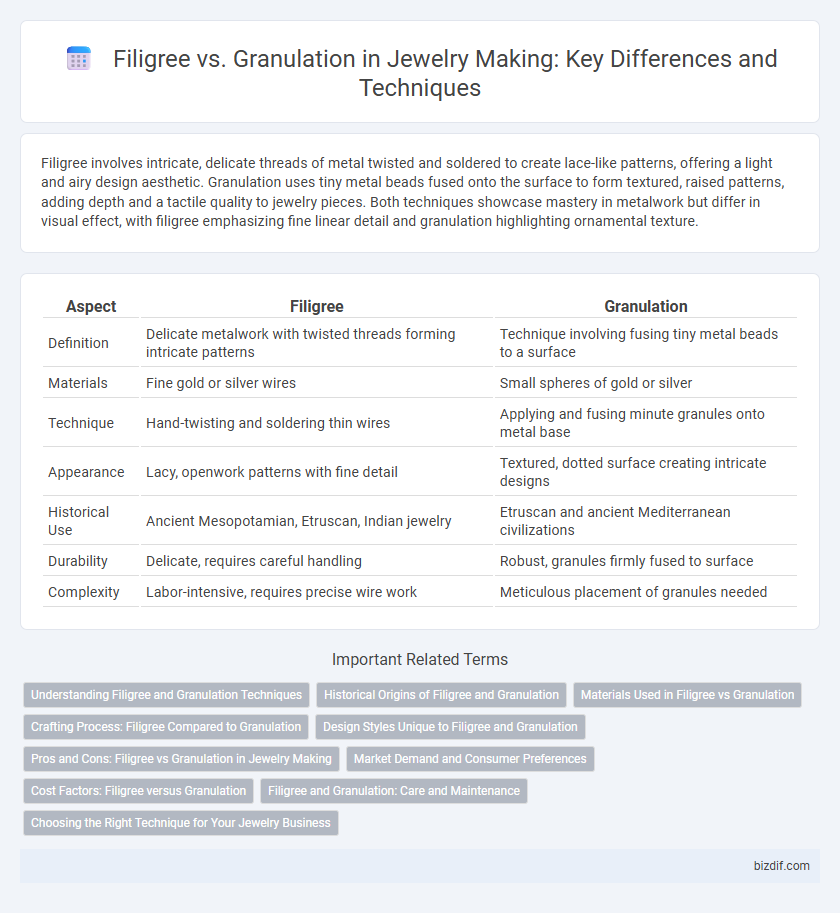Filigree involves intricate, delicate threads of metal twisted and soldered to create lace-like patterns, offering a light and airy design aesthetic. Granulation uses tiny metal beads fused onto the surface to form textured, raised patterns, adding depth and a tactile quality to jewelry pieces. Both techniques showcase mastery in metalwork but differ in visual effect, with filigree emphasizing fine linear detail and granulation highlighting ornamental texture.
Table of Comparison
| Aspect | Filigree | Granulation |
|---|---|---|
| Definition | Delicate metalwork with twisted threads forming intricate patterns | Technique involving fusing tiny metal beads to a surface |
| Materials | Fine gold or silver wires | Small spheres of gold or silver |
| Technique | Hand-twisting and soldering thin wires | Applying and fusing minute granules onto metal base |
| Appearance | Lacy, openwork patterns with fine detail | Textured, dotted surface creating intricate designs |
| Historical Use | Ancient Mesopotamian, Etruscan, Indian jewelry | Etruscan and ancient Mediterranean civilizations |
| Durability | Delicate, requires careful handling | Robust, granules firmly fused to surface |
| Complexity | Labor-intensive, requires precise wire work | Meticulous placement of granules needed |
Understanding Filigree and Granulation Techniques
Filigree and granulation are intricate jewelry making techniques that enhance metalwork with delicate details; filigree involves twisting thin metal wires into lace-like patterns, while granulation uses tiny metal beads fused onto the surface to create texture. Mastery of filigree requires precision in forming and soldering fine threads, whereas granulation demands control over bead size and uniform placement without visible solder joints. Both methods originate from ancient craftsmanship, enriching modern jewelry with detailed, decorative appeal and structural complexity.
Historical Origins of Filigree and Granulation
Filigree, originating over 5,000 years ago in Mesopotamia, is characterized by delicate, lace-like designs made from fine gold or silver threads twisted into intricate patterns. Granulation, dating back to the ancient Etruscans around 700 BCE, involves applying tiny gold beads to surfaces to create textured ornamental motifs. Both techniques showcase the advanced metalworking skills of ancient civilizations, reflecting cultural artistry and craftsmanship in early jewelry making.
Materials Used in Filigree vs Granulation
Filigree jewelry primarily utilizes fine gold, silver, or platinum wires meticulously twisted and soldered to create delicate lace-like patterns, emphasizing lightweight and intricate designs. Granulation involves the use of tiny metal spheres, often made from gold or silver, which are fused onto a surface to form textured, decorative motifs, requiring precise control of granule size and placement. Both techniques demand high-purity metals to ensure malleability and achieve the detailed craftsmanship characteristic of these traditional jewelry styles.
Crafting Process: Filigree Compared to Granulation
Filigree involves shaping fine metal wires into intricate, lace-like patterns that are soldered onto a jewelry base, showcasing delicate craftsmanship. Granulation uses tiny metal beads meticulously fused onto surfaces without visible solder, creating textured, ornamental designs. Both techniques demand precision but differ in tools and metal manipulation, with filigree emphasizing wirework and granulation focusing on bead placement.
Design Styles Unique to Filigree and Granulation
Filigree design style features intricate, lace-like patterns formed by twisting fine metal wires, creating delicate and airy motifs that emphasize elegance and complexity. Granulation showcases surfaces adorned with tiny, precisely placed metal beads, adding texture and dimension through minute, raised dots that catch light. Both techniques represent distinct artistic traditions, with filigree emphasizing linear fluidity and granulation focusing on detailed surface ornamentation in jewelry making.
Pros and Cons: Filigree vs Granulation in Jewelry Making
Filigree in jewelry making offers intricate, lace-like designs that showcase fine metal threads, providing lightweight and delicate aesthetics but can be fragile and prone to bending. Granulation involves fusing tiny metal beads onto surfaces, creating textured patterns with high durability and a unique tactile appeal, though it requires precise skill and can add weight to the piece. Both techniques enhance jewelry artistry; filigree is ideal for ornamental elegance, while granulation excels in robust, detailed embellishments.
Market Demand and Consumer Preferences
Filigree jewelry, known for its intricate wirework and delicate patterns, consistently attracts consumers seeking vintage and artisanal aesthetics, driving strong market demand in luxury and handcrafted segments. Granulation, characterized by tiny metal beads fused onto surfaces, appeals to buyers who favor textured, ornate designs with historical significance, sustaining niche popularity especially in ethnic and heritage collections. Consumer preferences increasingly favor customizable pieces, but filigree maintains broader appeal due to its versatility and perceived elegance in contemporary fashion trends.
Cost Factors: Filigree versus Granulation
Filigree jewelry typically involves intricate wirework using fine metals like gold or silver, resulting in higher labor costs due to the meticulous craftsmanship required. Granulation, which incorporates tiny metal beads fused to the surface, demands precision and specialized techniques that can increase production expenses. Material quality, complexity of design, and artisan skill levels significantly influence the overall cost differences between filigree and granulation jewelry.
Filigree and Granulation: Care and Maintenance
Filigree and granulation jewelry require delicate care to preserve intricate details and prevent damage. Avoid exposure to harsh chemicals and clean pieces gently with a soft brush and mild soap to maintain the fine metalwork and tiny granules. Store these artisanal pieces separately in padded containers to avoid scratches and deformation.
Choosing the Right Technique for Your Jewelry Business
Filigree and granulation offer distinct aesthetic appeals; filigree features delicate wirework creating intricate lace-like patterns, while granulation uses tiny metal beads to form textured surfaces. Choosing the right technique for your jewelry business depends on design style, production volume, and target market preferences, as filigree tends to require more time and skill, whereas granulation allows for versatile, tactile effects. Evaluating your brand identity and customer demand ensures the selected method enhances craftsmanship and marketability.
Filigree vs Granulation Infographic

 bizdif.com
bizdif.com